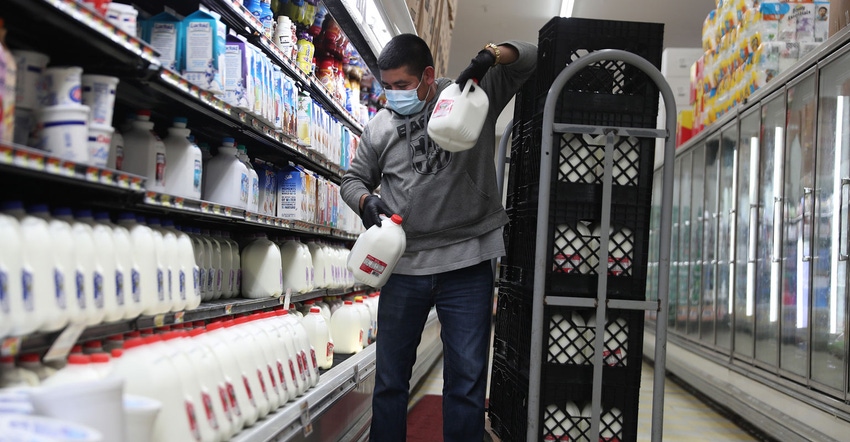April 28, 2020

U.S. dairy prices have taken a hit in the wake of the coronavirus pandemic, with Class III declining 26% and Class IV down 36% since the outbreak began.
The U.S. Dairy Export Council reports that exports were quite brisk up until March. In fact, exports in January and February were running above levels from the year before.
Related: Complete coronavirus coverage
With schools and foodservice institutions shut down, dairy sales have taken a hit. Surplus milk that can’t find a home is being dumped.
There are very few places that haven’t been affected by the virus outbreak. One bright spot is that retail sales of fluid milk and other dairy products, such as yogurt and cheese, are generally up.
Grim price outlook
The World Agriculture and Supply and Demand Estimates (WASDE) was released in early April, reflecting the outlook for lower prices ahead this year.
Annual cheese prices have been lowered from $1.7586 a pound in March to $1.3800 in the April estimate. Butter per pound has been lowered from $2.2431 to $1.4300. Nonfat dry milk has been lowered from an annual estimate of $1.0419 per pound to $0.9550, and dry whey was lowered from $0.3799 to $0.3450 in the April WASDE forecast.
Class prices have also been adjusted lower as a result of these updated product forecasts. Class III was lowered from $16.96 per cwt in March to $12.75 per cwt in April. Class IV was lowered from $16.30 to $12.15 in April. The all-milk price has been adjusted from the March estimate of $18.60 to $14.35 in April.
Keep in mind that these estimates reflect the current situation. Should the pandemic recede over the coming months and things start to return to normal, these estimates will be adjusted upward to reflect stronger demand and higher prices.
Milk keeps flowing
According to the USDA’s March Milk Production Report, overall milk production was up 2.4% in the top 24 milk producing states — 18.3 billion pounds — from February, which was 17 billion pounds.
Per-cow production was 2,072 pounds, up 34 pounds over last year. The number of cows was 8.85 million head, 64,000 more head over the year before and 5,000 more head than February.
March milk production in the top 24 states was the highest it’s been since May 2019. In the Northeast, milk production was up 2% in Pennsylvania — 907 million pounds total; up 2.1% in New York — 1.31 billion pounds total; and down 0.9% in Vermont — 232 million pounds total.
Growth like this is likely to reverse after the shock of this pandemic sets in.
All three states reported lower cow numbers in March over the previous year. Pennsylvania had 485,000 head, New York had 636,000 head and Vermont had 124,000 head.
Dairy producers are encouraged to stay abreast of any new programs offered by USDA that could result from the efforts being made by the National Milk Producers Federation, the International Dairy Foods Association or other organizations. Producers should also explore assistance programs being offered by Congress and the Small Business Administration.
Here are some other resources for getting through the COVID-19 pandemic on your farm:
“Novel Coronavirus Prevention & Control for Farms,” Cornell University Agricultural Workforce Development
“Preparing the Farm for the Novel Coronavirus,” Janzen Ag Law
“Food Industry Resources for Coronavirus,” Institute for Food Safety at Cornell University
“Dairy Defined,” a podcast available on Spotify and SoundCloud, by the National National Milk Producers Federation
Latta is a political and economic consultant for Northeast Dairy Foods Association Inc.
Read more about:
Covid 19About the Author(s)
You May Also Like




